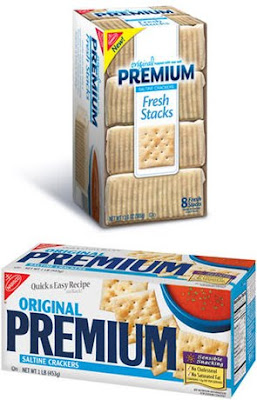wednesday, march 30, 2011
food inflation kept hidden in tinier bags
a stealth downsizing, as shoppers pay more for less food...
or: nabisco is cheating you out of precious saltines
 from nytimes: Chips are disappearing from bags, candy from boxes and vegetables from cans. As an expected increase in the cost of raw materials looms for late summer, consumers are beginning to encounter shrinking food packages. With unemployment still high, companies in recent months have tried to camouflage price increases by selling their products in tiny and tinier packages. So far, the changes are most visible at the grocery store, where shoppers are paying the same amount, but getting less...
from nytimes: Chips are disappearing from bags, candy from boxes and vegetables from cans. As an expected increase in the cost of raw materials looms for late summer, consumers are beginning to encounter shrinking food packages. With unemployment still high, companies in recent months have tried to camouflage price increases by selling their products in tiny and tinier packages. So far, the changes are most visible at the grocery store, where shoppers are paying the same amount, but getting less...
In every economic downturn in the last few decades, companies have reduced the size of some products, disguising price increases and avoiding comparisons on same-size packages, before and after an increase. Each time, the marketing campaigns are coy; this time, the smaller versions are “greener” (packages good for the environment) or more “portable” (little carry bags for the takeout lifestyle) or “healthier” (fewer calories). Where companies cannot change sizes — as in clothing or appliances — they have warned that prices will be going up, as the costs of cotton, energy, grain and other raw materials are rising.
“Consumers are generally more sensitive to changes in prices than to changes in quantity,” John T. Gourville, a marketing professor at Harvard Business School, said. “And companies try to do it in such a way that you don’t notice, maybe keeping the height and width the same, but changing the depth so the silhouette of the package on the shelf looks the same. Or sometimes they add more air to the chips bag or a scoop in the bottom of the peanut butter jar so it looks the same size.”
or: nabisco is cheating you out of precious saltines
 from nytimes: Chips are disappearing from bags, candy from boxes and vegetables from cans. As an expected increase in the cost of raw materials looms for late summer, consumers are beginning to encounter shrinking food packages. With unemployment still high, companies in recent months have tried to camouflage price increases by selling their products in tiny and tinier packages. So far, the changes are most visible at the grocery store, where shoppers are paying the same amount, but getting less...
from nytimes: Chips are disappearing from bags, candy from boxes and vegetables from cans. As an expected increase in the cost of raw materials looms for late summer, consumers are beginning to encounter shrinking food packages. With unemployment still high, companies in recent months have tried to camouflage price increases by selling their products in tiny and tinier packages. So far, the changes are most visible at the grocery store, where shoppers are paying the same amount, but getting less...In every economic downturn in the last few decades, companies have reduced the size of some products, disguising price increases and avoiding comparisons on same-size packages, before and after an increase. Each time, the marketing campaigns are coy; this time, the smaller versions are “greener” (packages good for the environment) or more “portable” (little carry bags for the takeout lifestyle) or “healthier” (fewer calories). Where companies cannot change sizes — as in clothing or appliances — they have warned that prices will be going up, as the costs of cotton, energy, grain and other raw materials are rising.
“Consumers are generally more sensitive to changes in prices than to changes in quantity,” John T. Gourville, a marketing professor at Harvard Business School, said. “And companies try to do it in such a way that you don’t notice, maybe keeping the height and width the same, but changing the depth so the silhouette of the package on the shelf looks the same. Or sometimes they add more air to the chips bag or a scoop in the bottom of the peanut butter jar so it looks the same size.”
No comments:
Post a Comment